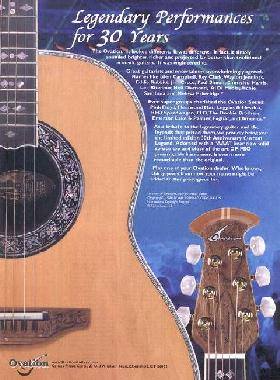|
|
Joined:
July 2003
Posts: 181
Location: North Carolina | I have a question for all you guitar techs out there to help improve my understanding of the guitar:
Leveling and dressing frets obviously lowers the frets a bit. What effect does fret height have on sound and playability? Thanks.
Franklin |
|
| |
|
Joined:
February 2003
Posts: 299
Location: Netherlands | Too low frets cause stringbuzz but have a positive effect on playability (remember the Gibson LP 'fretless wonder? Very Very low broad frets).
Too high frets may cause intonation problems, because strong hands may bend the notes toward the fretboard. However, this is exactly what happens with scalloped fretboards used on e.g. the Fender Yngwie Malmsteen signature.
I personally like low, broad frets as I have them on my Adamas SMT and my Ibanez Roadstar II. I generally prefer my Fender Telecaster over the Roadstar, but playability is a bit less IMO due to narrower fretwire and a bit higher frets.
Leveling and dressing frets normally should not result in big loss of height.
Martin |
|
| |
|
Joined:
July 2002
Posts: 1900
| speaking of frets...
the frets on my custom balladeer can be filed/leveled/dressed once more before they are replaced; then i have been considering finding the hardest frets available; i have heard there are stainless steel or even titanium frets available now; does anyone have more specific information about the variety of frets which are available? thanks....
steve |
|
| |
|
Joined:
February 2002
Posts: 5750
Location: Scotland | There is a payoff with harder frets. The harder the fret the faster they wear the strings. Luthiers tend tend to dislike harder frets because they dull tools faster and are a little more difficult to dress. Nickel-sliver is a nice compromise between fret durability & string durability. |
|
| |
|
Joined:
July 2002
Posts: 1900
| hi paul, thanks for the info; i still want the hardest frets i can get; the ovatiion frets are too soft; let me know which frets are the hardest...thanks, steve |
|
| |
|
Joined:
February 2002
Posts: 5750
Location: Scotland | What makes you think Ovation frets, are "too soft"? I have a '68 Balladeer that has yet to have a re-fret, A '78 Adamas that was re-fretted for the first time about 6 years ago & an SMT that's done over a hundred gigs a year for the last 3 years and isn't showing any signs of wear. If you own one guitar and play constantly in the first few positions then you'll wear those frets, especially under the plain strings, pretty quick. Having those frets dressed every couple of years is a minor expense, as is a partial re-fret when they get beyond dressing.
To answer the original question - Low frets generally allow a slightly lower action. Low narrow frets tend to intonate more accurately across the playable range. Low wide frets make the neck feel "faster" but intonation may suffer. Personally I can live with standard frets. |
|
| |
|
Joined:
July 2002
Posts: 1900
| I might consider them soft because my balladeer is the only guitar I play so they wear faster; i obtained it in '86 and this will be my third set of frets, unless they can be dressed/filed one more time; and I like them low and fast as well, especially because the intonation is consistent; I asked ovation about their original fret wire for my particular guitar but they never responded, so I am trying to find the hardest/lowest frets available; I found one source for stainless steel so far.... |
|
| |
|

Joined:
August 2003
Posts: 4619
Location: SoCal | When is it appropriate to have a fret dress done? From what I understand, it is when a small grove has been worn into the fret and the dressing is designed to level the fret. So, the fret dressing is merely leveling the fret?
And, a fret replacement when the frets are so damaged as to affect the playability? |
|
| |
|
Joined:
February 2002
Posts: 5750
Location: Scotland | Steve, are you saying 3 re-frets since '86 or 3 fret-dressings? If it's your primary guitar, played regularly, then 3 fret dressings and an up-coming re-fret in 17 years is pretty damn good.
Tony, a fret dress becomes necessary when the frets become indented to the extent that the strings rattle against higher frets. Usually frets can be dressed, which means lowering & re-profiling (or "crowning") 2 or 3 times before they become too low and a re-fret is needed. Sometimes a partial re-fret is possible. |
|
| |
 Fret Height Question
Fret Height Question Fret Height Question
Fret Height Question